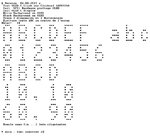Praveen Kumar P S
Member level 4
Hello Guys,
I was writing a program for my SSD1306 oled display from scratch without any third party. I have successfully initialized the display. But I dont know the logic to turn on the pixels for a particular ascii character. I am stuck with the logic to print a character on the display. Help needed guys.
Thank you
I was writing a program for my SSD1306 oled display from scratch without any third party. I have successfully initialized the display. But I dont know the logic to turn on the pixels for a particular ascii character. I am stuck with the logic to print a character on the display. Help needed guys.
Thank you
